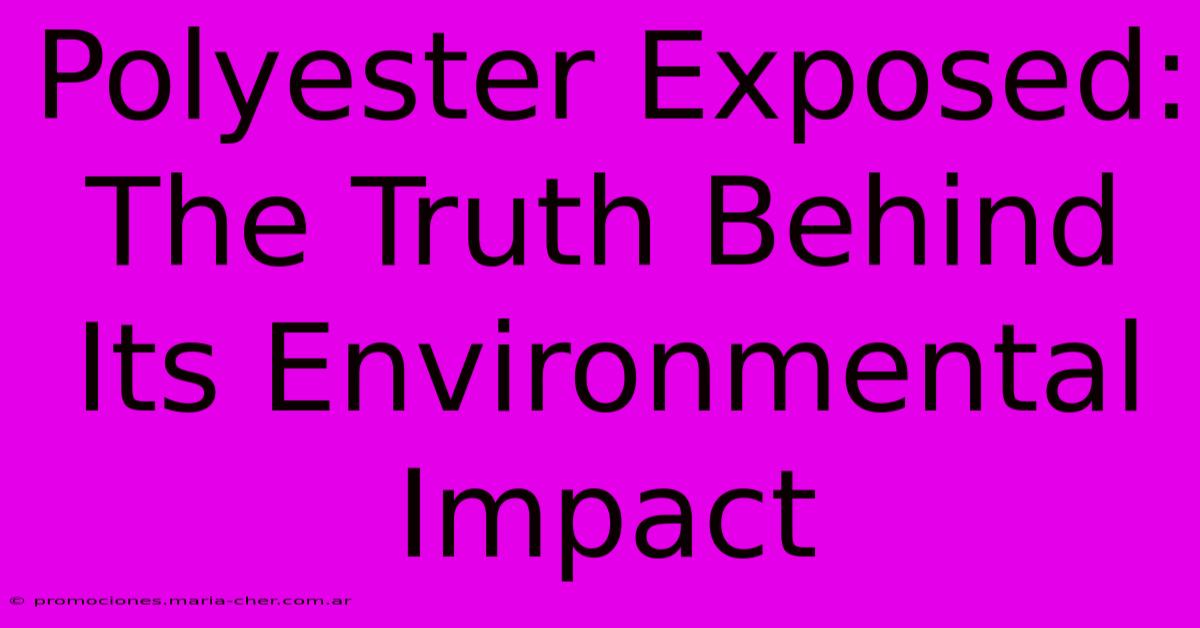Polyester Exposed: The Truth Behind Its Environmental Impact

Table of Contents
Polyester Exposed: The Truth Behind Its Environmental Impact
Polyester. It's everywhere. From our clothing to our furniture, this synthetic fabric is ubiquitous. But behind its affordability and versatility lies a complex and often troubling environmental impact. This article delves into the truth about polyester, exploring its lifecycle from production to disposal and examining the consequences for our planet.
The Production Process: A Petrochemical Playground
Polyester's journey begins with petroleum. This reliance on fossil fuels is a major contributor to its environmental footprint. The extraction, processing, and transportation of oil all release greenhouse gases, significantly contributing to climate change. The manufacturing process itself is energy-intensive, further exacerbating the carbon emissions associated with polyester production.
Microplastic Pollution: A Growing Concern
One of the most significant and alarming consequences of polyester production and use is microplastic pollution. During washing, tiny fibers shed from polyester garments enter our waterways, eventually making their way into oceans and harming marine life. These microplastics persist in the environment for centuries, disrupting ecosystems and potentially entering the food chain.
The Consumption Conundrum: Fast Fashion and its Fallout
The rise of fast fashion has exacerbated the negative environmental impacts of polyester. The low cost and readily available nature of polyester clothing have fueled a culture of disposability, leading to a massive increase in textile waste. The "throw-away" mentality contributes to overflowing landfills and increased pollution.
Water Consumption: A Hidden Cost
While not as immediately visible as microplastic pollution, the water footprint of polyester production is substantial. The manufacturing process requires significant amounts of water, placing strain on already stressed water resources in many parts of the world. This hidden cost of polyester often goes unnoticed by consumers.
Disposal and Degradation: A Long and Lingering Problem
Polyester is incredibly slow to decompose. It can persist in landfills for hundreds of years, contributing to a growing problem of textile waste. Incineration, while reducing landfill volume, releases harmful toxins into the atmosphere. Recycling polyester is challenging due to its complex chemical structure, and current recycling rates remain low.
Alternatives to Polyester: Sustainable Solutions
Fortunately, there are increasingly viable alternatives to polyester. Organic cotton, hemp, tencel, and recycled materials offer more environmentally friendly options. These alternatives often require less energy and water to produce, generate fewer greenhouse gas emissions, and are biodegradable. Choosing sustainable materials is a crucial step in mitigating the environmental consequences of textile production.
What You Can Do: Making Conscious Choices
As consumers, we have a significant role to play in reducing the environmental impact of polyester. Here are some actions you can take:
- Buy less: Resist the urge to constantly buy new clothing. Choose quality over quantity and invest in durable, long-lasting garments.
- Choose sustainable alternatives: Opt for clothing made from organic cotton, hemp, tencel, or recycled materials whenever possible.
- Wash clothes less frequently and with care: Reduce the amount of microplastics released into the environment by washing clothes less frequently and using cold water and a low spin cycle.
- Support brands committed to sustainability: Research and support companies that prioritize environmentally friendly practices throughout their supply chain.
- Recycle and repurpose: Explore options for recycling or repurposing old clothes instead of discarding them in landfills.
By understanding the environmental impact of polyester and making conscious choices, we can collectively contribute to a more sustainable future for the fashion industry and our planet. The future of fashion depends on our willingness to embrace change and adopt more responsible practices.

Thank you for visiting our website wich cover about Polyester Exposed: The Truth Behind Its Environmental Impact. We hope the information provided has been useful to you. Feel free to contact us if you have any questions or need further assistance. See you next time and dont miss to bookmark.
Featured Posts
-
Tangerine Tango The Unexpected Nail Color Thats Making Waves
Feb 09, 2025
-
Liver Panel Cost The Hidden Signs You Ll Regret Ignoring
Feb 09, 2025
-
Unveiling The Dark Side What Lurks Behind The Red Line Flag
Feb 09, 2025
-
Liver Panel Cost Exposed How Much Should You Really Pay
Feb 09, 2025
-
Uncover The Hidden Truths Acl Reconstruction Surgery Cost Exposed
Feb 09, 2025
